ASUS U35Jc: Jogging in Place
by Dustin Sklavos on September 30, 2010 3:00 AM ESTBattery, Noise, and Heat
ASUS makes one of the most amusingly outlandish claims about battery life we've read in a long time. On their page for the U35Jc, they suggest their "Super Hybrid Engine" combined with NVIDIA's Optimus technology allows the notebook to pull 11.5 hours of running time. It's been a long time since manufacturers have been that brazen, especially when (as you'll see) the product still produces admirable running time on its own.
Update: It appears our battery was functioning at less than ideal levels during our initial testing. We've been rerunning the tests to see if we can improve the scores. Our idle and internet results have already improved by 12% (no change on x264 playback), without using SHE, so we're going to run the whole battery suite with SHE enabled to see what we can get. We'll update the charts and text when we have final results. The current charts contain the original results.
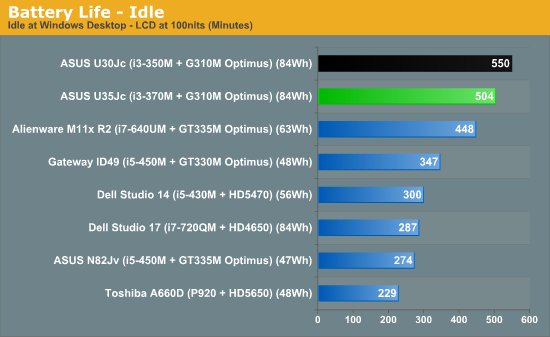
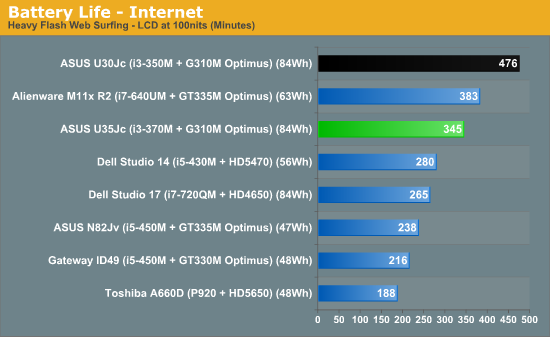
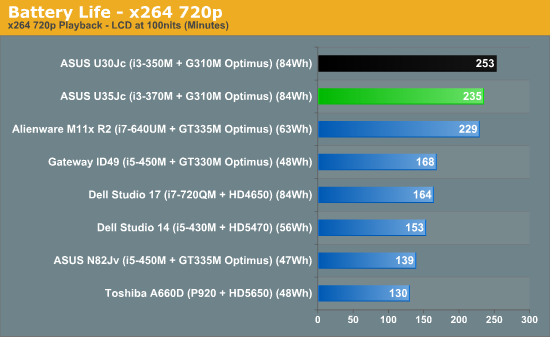
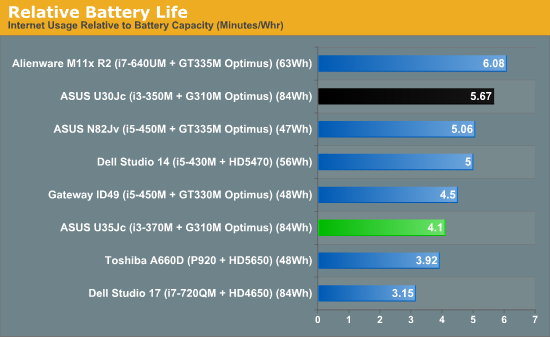
Uh oh. While the battery life of the U35Jc is excellent, it can't keep up with the U30Jc. It's possible that enabling the Asus "Super Hybrid Engine" (left disabled by default) could extend the U35Jc's running time enough for it to catch up to its sibling, but the gulf at idle and especially during internet usage is wide. It's only when a more constant load is applied to the system—during our 720p playback test—that the gap closes. The two major differences between the two notebooks are the slightly faster processor in the U35Jc and the slightly improved screen (more on that on the next page). Maybe there's a difference in heat and, correspondingly, how much the fan has to run.
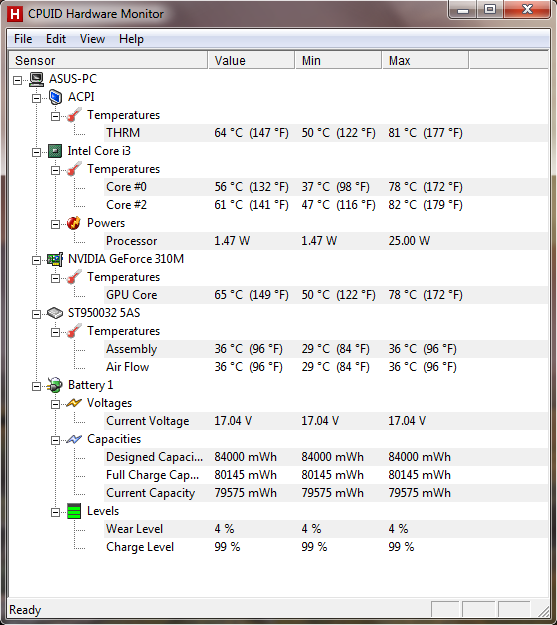
Well, there's at least some explanation. The battery on our review unit is operating at a reduced capacity, substantial enough to account for a small portion of the difference. However, we still need 31% more for the quoted 11.5 hour mark. Even if we enable SHE, run the LCD at 0% brightness, and don't touch the laptop we can't get there. Realistically, we're looking at 9 hours as a more likely result, which is still good. Unless there's some trick to improving battery life further that we've missed--it's still odd that the U30Jc posts substantially better battery life with the same battery--ASUS should curtail their claims. Or maybe they just need to make sure all the batteries and processors they use in the U35Jc are at the same level.
Thermals for the U35Jc after an hour of 3DMark06 were actually pretty good. Processor and GPU temperatures both stayed reasonable given the continued stress on the notebook. The warmest part of the surface was near the exhaust vent on the left side, but it wasn't as scorchingly hot as, say, the same region on the Gateway ID49 we recently reviewed. Complaints about the lack of ventilation around the hard disk also seem fairly ill-founded: the drive peaked at a frosty 36C.
Fan noise wasn't a huge issue either. While the fan did spin up substantially when the system was placed under constant load, it remained a fairly low "whoosh." The difference is noticeable, but not dramatic, and for most users should be fine.










45 Comments
View All Comments
Dustin Sklavos - Thursday, September 30, 2010 - link
I have to disagree with you. The layout on this notebook has been a standard for a long time now, and it's something I'm very comfortable with and know a few people who feel the same way. I'm a pretty good touch typist and have never had any of the problems you cite, though that's admittedly anecdotal.ran100 - Thursday, September 30, 2010 - link
Now, when nvidia has already announced DX 11.0 series mobile graphics card with optimus technology. It is pity that manufacturers are yet to update. I want a notebook with gtx 460m and optimus. The panel of good quality is certainly important.JarredWalton - Thursday, September 30, 2010 - link
This laptop design was finished and being built probably 3-4 months ago at least, so it's no surprise that they didn't go to 400M. Still, 310M was such a slow card that I really hope it disappears quickly....tno - Thursday, September 30, 2010 - link
I mean this thing is less interesting as far as I'm concerned than a MacBook speed bump. I think sending this one back to Asus and demanding they try again when they have something interesting to review would have been warranted. These should have been released side by side as the U30optical and the U30lite.Jeffk464 - Thursday, September 30, 2010 - link
Nope, nope, nope, must wait for the sangdybridge based version with a 15" monitor. Or maybe a AMD zacate 13" version.zhill - Thursday, September 30, 2010 - link
First, your laptop reviews are the best around as far as I'm concerned, but I have one minor gripe: the choice of comparison machines in the performance/battery tests is somewhat confusing to me. For instance, why not include the protege r700 and the asus u33jc in the graphs as those a contenders for anyone interested in a 13" portable? I understand that you want to throw in an i5, i7um etc and one or two machines from different segements, but it gets old having to look back through old reviews to get the numbers for comparisons. Maybe a Bench addition (like CPU/SSD/GPU Bench) so we can pick our own comparisons to see the data? That would be great.On a positive note, your battery life/wH is a great metric for efficiency and levels the playing field when considering what a higher-capacity upgrade battery might do. Keep up the good work!
JarredWalton - Thursday, September 30, 2010 - link
I'd be interested in hearing your input as to what's "ideal" in terms of charts. I personally think around 8~10 systems is good, as otherwise it gets too cluttered. Dustin I think prefers closer to 6 systems. So, if anyone else has an opinion here let us know! We can obviously put a bunch of the other systems we've reviewed into the charts, but at some point we pass the useful stage and move into information overload.As for Mobile Bench, we've talked about it. I guess I just need to chat with Anand some more and see how soon we can make it happen. :-)
zhill - Thursday, September 30, 2010 - link
First, thanks for the quick response.As for the "ideal" chart presentation, I think that the number of systems you present is just about right--8 systems is perfectly reasonable. However, unless a particular unit performs way above or below its "weight-class" (in the sporting sense) or has some really new/interesting hardware (i.e. the first example of a new CPU/generation), I'm really only interested in similar products, not, for instance, the Studio 17 vs U30JC. However, if a model is particularly bad or really good (rare these days with very similar hardware configs) then some out-of-class comparisons are useful. It's not an easy thing to determine, which is why an interactive system would be perfect as an option. So for the u35jc a nice comparison set might be: r700, u30jc, u33jc, m11x, studio 14, macbook pro-13, and maybe throw in the vaio Z to see what 2X cost gets you. Obviously, these are my personal preferences and relate to how and why I read a review.
Again, great reviews overall. You guys are the only ones who cover the LCDs and keyboards well. I've read far too many other review with "keyboard was good" simply because it's full sized, but in practice the thing is full of mush and terrible. These reviews are particularly great for models that aren't readily available in stores to try out.
vol7ron - Thursday, September 30, 2010 - link
"...a disappointment when 7200 RPM drives have gotten so much cheaper. Power consumption differences between 5400 RPM and 7200 RPM drives can be fairly negligible at this point, so there's really no excuse for going with the faster hardware."Should it be "no excuse for going with the [slower] hardware", or "...for [not] going with the faster hardware"?
JarredWalton - Thursday, September 30, 2010 - link
Fixed.